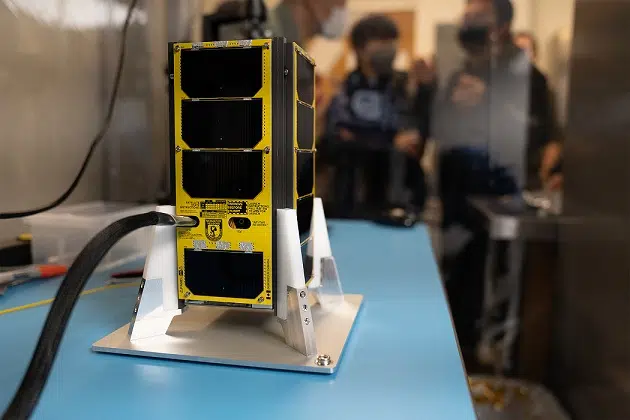
A satellite designed by local scientists is set to launch into space in an upcoming SpaceX mission.
The Port Elgin based Nuclear Innovation Institute’s (NII) Chief Innovation Officer Dr. Eric Johnston and Bruce Power’s Dr. Andrei Hanu teamed up with McMaster University Professor Dr. Soo-Hyun Byun, to build a device meant to detect radiation in space.
A release from the NII says, “As countries prepare to expand humanity’s presence to new locations in the solar system, astronauts will need to overcome the risks associated with prolonged exposure to space radiation.” The scientists will be extracting information from the satellite to see what kind of protections would be needed for humans to be on the moon or Mars for a period of time.
With funding from Bruce Power through the Environment@NII program and supported by NII, Johnston and Hanu worked with the McMaster team to develop the NEUtron DOSimetry & Exploration-or NEUDOSE (pronounced “new dose”) satellite.
The satellite is about the size of a loaf of bread. Inside it is the actual measuring instrument, which behaves like regular human fat tissue would, absorbing space radiation and relaying those measurements to us on Earth.
The project has been years in the making, and on March 14th, if the launch goes ahead, the team will see their work launch on a SpaceX rocket from Kennedy Space Center in Florida.
The satellite will travel to the International Space Station, where astronauts will eventually release it into orbit around Earth.
The NII says the last time a human has ventured beyond low-Earth orbit was December 1972.
Dr. Hanu explains in a statement, “From a human health perspective, exposure to space radiation is one of the top ten challenges we must contend with if humans are travelling beyond low-Earth orbit.”
The NII says radiation outside of Earth’s protective atmosphere and magnetosphere is more intense and contains particles of significantly higher energy than what people receive each day on this planet. For a mission to Mars, for example, it would take six to nine months to get there, then astronauts would wait until Mars and Earth’s orbits are aligned, so they would stay on the planet for about a year. It would take another six to nine months to get back. That means two to three years in space.
According to the NII, each year on Earth, the average person receives radiation equal to about 300 dental x-rays, from sources like solar winds and cosmic rays, air travel and health procedures, as well as natural radiation from the planet itself.
In space, those two to three years could mean a radiation dose of two to three sieverts-that’s 200,000 to 300,000 times higher than a dental x-ray. Or, according to the American College of Radiology, two to three times as high as a person should receive in their entire lives.
One sievert increases a person’s likelihood of fatal cancer by 5 per cent.
The NII says, in Canada, the dose limit to the public as a result of nuclear plant operations is one millisievert (1/1000 of a sievert) in one calendar year. Regular reporting and monitoring by Canada’s nuclear regulator demonstrate the average annual effective doses to the public range from 0.001 to 0.002 millisieverts per year and between 0.5 to 0.7 millisieverts for nuclear plant workers.
The NII explains, what separates the NEUDOSE instrument from other detectors is its capability to measure both the radiation dose and the type of the radiation that caused it, which is important when looking at the long-term risks of ionizing radiation.
“By understanding the risks through projects like NEUDOSE,” said Dr. Hanu. “We can design shielding that is more effective and figure out how to get the most out of the heavy radiation shielding in a spacecraft.”
Dr. Johnston agrees: “Once the satellite begins reporting data in the coming months, we hope to make some major scientific findings that will help us develop better radiation instruments that enhance an astronaut’s situational awareness and the type of radiation they are exposed to.”
“With a diverse team of McMaster students and professors, industry experts and the Canadian Space Agency, this innovation project is an example of years-long collaboration to create a unique instrument,” said Dr. Johnston. “We are very grateful for the ongoing support of Bruce Power and NII’s other Founding Members.”
Senior Director at Bruce Power Danielle Lacroix says in a statement, “We’re excited to support this important research that will have impacts far beyond our traditional borders and into the realm of space which is truly inspiring,” said Danielle Lacroix, Senior Director at Bruce Power. “The fact this project aims to enhance the safety of astronauts aligns closely with our values, and along with our founding partners at NII, we will be watching the March 14 launch closely as we help increase our collective understanding in this fascinating area of science.”
NII President and CEO Bruce Wallace and NII Chief Innovation Officer Dr. Eric Johnston were on the Open Line Show on AM 560 CFOS Tuesday, March 7th. You can listen to them below:
https://news.google.com/rss/articles/CBMiZmh0dHBzOi8vd3d3LmJheXNob3JlYnJvYWRjYXN0aW5nLmNhLzIwMjMvMDMvMDkvbG9jYWwtc2NpZW50aXN0cy10by1sYXVuY2gtc2F0ZWxsaXRlLWluLXNwYWNleC1taXNzaW9uL9IBAA?oc=5
2023-03-09 13:58:38Z
1830542452
Tidak ada komentar:
Posting Komentar